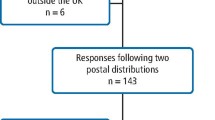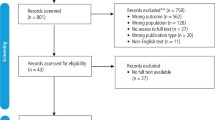Abstract
Aims To explore the subjective experience of a sample of patients attending a dental teaching hospital emergency clinic with toothache.
Materials and methods Subjects 21 female and 14 male dental patients, of different ages, marital status, employment status and levels of education, presenting with toothache at a dental teaching hospital emergency clinic. Data collection Unstructured in-depth interviews, following a topic guide. Analysis Transcribing, sifting, indexing and charting data according to key issues and themes.
Findings A dimension of toothache pain that emerged was the perceived inability to cope. Patients reported a dependency on a dentist or other person to alleviate their pain, suggesting connotations of helplessness, disempowerment and incapacitation. The perceived inability to cope was also expressed in terms of loss of control, despair and isolation. A number of care-seeking patterns for toothache was identified: repeated visits to the same dentist for emergency care, repeated visits to different dentists, attendance at the dental hospital emergency clinic and consulting non-dental health workers such as doctors and pharmacists.
Conclusions The perceived inability to cope and care-seeking patterns are two unexplored dimensions of the toothache pain experience. Both dimensions may be associated with pain intensity, the clinical conditions that manifest as toothache, quality of treatment provided and management of demand for emergency dental care. A conceptual framework is proposed for future research to investigate these relationships.
Similar content being viewed by others
Log in or create a free account to read this content
Gain free access to this article, as well as selected content from this journal and more on nature.com
or
References
Locker D, Grushka M . Prevalence of oral and facial pain and discomfort: preliminary results of a mail survey. Community Dent Oral Epidemiol 1987; 15: 169–72.
Jaafar N, Razak I A, Zain R B . The social impact of oral and facial pain in an industrial population. Annals Acad Med 1989; 18: 553–555.
Lipton J A, Ship J A, Larach-Robinson D . Estimated prevalence and distribution of reported orofacial pain in the United States. JADA 1993; 124: 115–121.
Richards W, Scourfield S . Oral ill-health in a general dental practice in South Wales. Primary Dent Care 1996; 3: 6–13.
Cushing A M, Sheiham A, Maizels J . Developing socio-dental indicators - the social impact of dental disease. Community Dent Health 1986; 3: 3–17.
Gooch B F, Dolan T A, Bourque L B . Correlates of self-reported dental health status upon enrolment in the Rand Health Insurance Experiment. J Dent Educ 1989; 53: 629–637.
Atchison K A, Dolan T A . Development of the Geriatric Oral Health Assessment Index. J Dent Educ 1990; 54: 680–686.
Locker D, Miller Y . Evaluation of Subjective Oral Health Status Indicators. J Public Health Dent 1994; 54: 167–176.
Slade G D, Spencer A J . Development and evaluation of the Oral Health Impact Profile. Community Dent Health 1994; 11: 3–11.
Burke F J T, McCord J F, Cheung S W . The provision of emergency dental care by general dental practitioners in an urban area. Dent Update 1994 June: 184–186.
Leao A, Sheiham A . Relation between Clinical Dental Status and Subjective Impacts on Daily Living. J Dent Res 1995; 74: 1408–1413.
Riley J L III, Gilbert G H, Heft M W . Orofacial pain symptom prevalence: selective sex differences in the elderly? Pain 1998; 76: 97–104.
Kerns R D, Turk D C, Rudy T E . The West Haven-Yale Multidimensional Pain Inventory (WHYMPI). Pain 1985; 23: 345–356.
Cameron L, Leventhal E A, Leventhal H . Symptom representations and affect as determinants of care seeking in a community-dwelling, adult sample population. Health Psychol 1993; 12: 171–179.
Riley J L III, Gilbert G H, Heft M W . Healthcare utilisation by older adults in response to painful orofacial symptoms. Pain 1999; 81: 67–75.
McGlynn F D, Gale E N, Glaros A G, LeResche L, Massoth D L, Weiffenbach J M . Biobehavioural research in dentistry: some directions for the 1990s. Annals of Behavioural Med 1990; 12: 133–140.
Salmon P, Manyande A . Good patients cope with their pain: postoperative analgesia and nurses' perceptions of their patients' pain. Pain 1996; 68: 61–68.
East London and The City Health Authority (1998). Research Ethics Committee: Notes for Guidance on Research Ethics.
Mays N, Pope C . Rigour and qualitative research. In Mays N, Pope C (eds) Qualitative Research in Health Care. Ch 2. London: BMJ, 1996.
Mays N, Pope C . Assessing quality in qualitative research. BMJ 2000; 320: 50–52.
Britten N . Qualitative interviews in medical research. In Mays N, Pope C (eds) Qualitative Research in Health Care. Ch 2. London: BMJ, 1996.
Hakim C . Research Design. London: Routledge, pp 27.1987.
Ritchie J, Spencer L . Qualitative data analysis for applied policy research. In Bryman A and Burgess R G (eds) Analysing qualitative data. Ch 9. London: Routledge, 1994.
Thomas R J, McEwen J, Asbury A J . The Glasgow Pain Questionnaire: A new generic measure of pain; development and testing. Int J Epidemiology 1996; 25: 1060–1067.
Penchansky R, Thomas J W . The concept of access: definition and relationship to consumer satisfaction. Med Care 1981; 92: 127–40.
Raspe H, Kohlmann T . Disorders characterised by pain: a methodological review of population surveys. J Epidemiology Community Health 1994; 48: 531–537.
Melzack R . The McGill Pain Questionnaire: major properties and scoring methods. Pain 1975; 1: 277–299.
Author information
Authors and Affiliations
Corresponding author
Additional information
Refereed paper
Rights and permissions
About this article
Cite this article
Pau, A., Croucher, R. & Marcenes, W. Perceived inability to cope and care-seeking in patients with toothache: a qualitative study. Br Dent J 189, 503–506 (2000). https://doi.org/10.1038/sj.bdj.4800812
Received:
Accepted:
Published:
Issue date:
DOI: https://doi.org/10.1038/sj.bdj.4800812
This article is cited by
-
Current diagnosis of dentin hypersensitivity in the dental office: an overview
Clinical Oral Investigations (2013)
-
Evidence summary: what do we know from qualitative research about people's care-seeking about oral health?
British Dental Journal (2010)
-
Patient expectations of emergency dental services: a qualitative interview study
British Dental Journal (2004)



